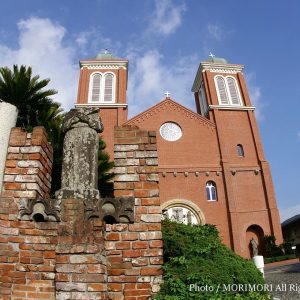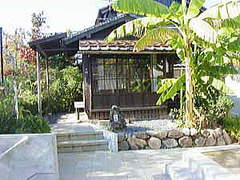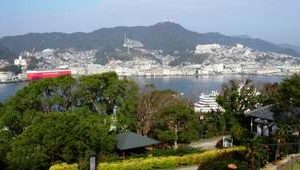 ■ A believer who said that the bombing was a grace of God
■ A believer who said that the bombing was a grace of God A devout Catholic, Takashi Nagai is known for his series of A-bomb-related works. Nagai, who went on to Nagasaki Medical University from the former Matsue High School, stayed near the university. The boarding house is a hidden Christian family who survived the persecution of the Edo period, and is married to the daughter of that family and is baptized by Catholicism.
The words "The fall of the atomic bomb is a great providence. It is the grace of God" written in his masterpiece "Bell of Nagasaki" has caused a great deal of controversy as it leads to the acceptance of the atomic bomb. Intellectuals such as novelist Shigeharu Nakano and local poet Kan Yamada had begun to criticize him as an "uninvited spokesman." The novelist Hisashi Inoue criticized that "it was used by GHQ to contribute to exempting the war responsibility of Japanese leaders with the emperor at the top and to spread the idea of exempting the responsibility of dropping the atomic bomb" ( The above-mentioned Motoshima's biography, p. 233).
The same Catholic believer, Hitoshi Motoshima, said, "Nagai did not intend to impose thoughts on anyone other than the believers." " There can be no victory in a war that is not justice before. "
From the standpoint of the residents of Kokura, who "lived at the sacrifice of Nagasaki," it can be said that Urakami suffered the worst and worst suffering of the fifth collapse on August 9, 1945. Takashi Nagai's words can be paraphrased as "Urakami is a hill of Golgotha, and the people who were exposed to the bomb are martyrs." Did the people of Kokura, who miraculously escaped the difficulties, delve into the meaning of the atomic bombing of Nagasaki?
Note: Please refer to the article published on August 9, 2021 "Thinking about the former Mayor of Nagasaki, beyond the position of the victim in 1976."
■ Gide's question
The reconstructed Urakami Cathedral was sparse and quiet on weekday evenings just before Christmas. The sun, which tilted greatly to the west, passed through the stained glass and colored the inside of the hall with pale red, blue, and green.
The appearance of the collapse in an instant due to the bombing cannot be seen here. It is said that the church was a sacred place for believers to be connected with God and could not be preserved like the Atomic Bomb Dome in Hiroshima. The front entrance of the Cathedral, which turned into rubble immediately after the bombing, is reproduced in the Nagasaki Atomic Bomb Museum in its original size.
 Takashi Nagai's old house "Nyoko-do" = photo = is about a 15-minute walk from Urakami Cathedral. He wrote a series of books for six years with unbelievable mental strength while lying down with the atomic bomb in just two tatami mats. "Nyoko" is named after the words "Love people like yourself" in Mark 12:31 of the New Testament.
Takashi Nagai's old house "Nyoko-do" = photo = is about a 15-minute walk from Urakami Cathedral. He wrote a series of books for six years with unbelievable mental strength while lying down with the atomic bomb in just two tatami mats. "Nyoko" is named after the words "Love people like yourself" in Mark 12:31 of the New Testament. Standing there, I remembered André Gide's Soviet travelogue, which traveled to the Soviet Union after the Russian Revolution. Gide finds an intolerant bias towards anger and hatred in Soviet society. Western intellectuals in the first half of the 20th century, who thought of an equal society and were devoted to communism, are actually disappointed.
Gide, who visited the Soviet Union, which became a magnificent experimental site, discovered the system of obedience and adaptation, the poverty of the people, and the deception and swearing of bureaucrats.
In the baby boomer generation, which became the core of the Zenkyoto movement in the late 1960s, there were those who justified Lynch murder in the name of revolutionary violence. This was linked to Stalin's logic of purge. Isn't the feelings of the intellectuals in Tokyo who criticized Nagai as if they despised it overlap with the above-mentioned swearing?
We must live in a world of godlessness. How do you beg for forgiveness?
(To be continued)
 Nagasaki Bay = photo, which is surrounded by Christmas illuminations at night and shines brightly in the sunlight during the day. The prayer "to the last bombed area of humankind" is conveyed by the sound of the bell ringing at the hypocenter, Urakami Cathedral. It has been 76 years since August 9, 1945. Forty-five years have passed since we covered the Peace Memorial Ceremony on August 9, 1976. The Nagasaki Shimbun, a local newspaper purchased on the morning of December 21, 2021, posted the top article on the front page, "The First Conference of the Parties to the Nuclear Ban Treaty: The United States Requests Japan Not to Participate. Japan Synchronizes." Japan is the only country that has been bombed. However, it is a protectorate of the United States, which is not even allowed to participate in observers at the Conference of the Parties to the Treaty on the Prohibition of Nuclear Weapons due to the opposition of the United States, the de facto suzerain. While visiting the A-bombed ruins in Nagasaki, I strengthened my desire to renew the system of postwar Japan, which continues to be bound by the United States and Britain.
Nagasaki Bay = photo, which is surrounded by Christmas illuminations at night and shines brightly in the sunlight during the day. The prayer "to the last bombed area of humankind" is conveyed by the sound of the bell ringing at the hypocenter, Urakami Cathedral. It has been 76 years since August 9, 1945. Forty-five years have passed since we covered the Peace Memorial Ceremony on August 9, 1976. The Nagasaki Shimbun, a local newspaper purchased on the morning of December 21, 2021, posted the top article on the front page, "The First Conference of the Parties to the Nuclear Ban Treaty: The United States Requests Japan Not to Participate. Japan Synchronizes." Japan is the only country that has been bombed. However, it is a protectorate of the United States, which is not even allowed to participate in observers at the Conference of the Parties to the Treaty on the Prohibition of Nuclear Weapons due to the opposition of the United States, the de facto suzerain. While visiting the A-bombed ruins in Nagasaki, I strengthened my desire to renew the system of postwar Japan, which continues to be bound by the United States and Britain.  ■ A believer who said that the bombing was a grace of God
■ A believer who said that the bombing was a grace of God Takashi Nagai's old house "Nyoko-do" = photo = is about a 15-minute walk from Urakami Cathedral. He wrote a series of books for six years with unbelievable mental strength while lying down with the atomic bomb in just two tatami mats. "Nyoko" is named after the words "Love people like yourself" in Mark 12:31 of the New Testament.
Takashi Nagai's old house "Nyoko-do" = photo = is about a 15-minute walk from Urakami Cathedral. He wrote a series of books for six years with unbelievable mental strength while lying down with the atomic bomb in just two tatami mats. "Nyoko" is named after the words "Love people like yourself" in Mark 12:31 of the New Testament. 